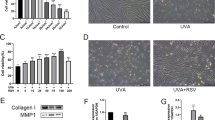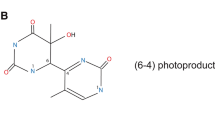Abstract
Recently, we reported that the herbal drug St. John's Wort is a potent inhibitor of UV-induced HIV-LTR activation in stably transfected HIVcat/HeLa cells [35]. Our previous studies have demonstrated that the activation of p38 MAP kinase (stress-activated protein kinase-2) and NF-κB are both required for a full UV-induced HIV gene expression response. In this study we have investigated the mechanism by which curcumin inhibits UV-activated HIV-LTR gene expression. We found that treatment of HIVcat/HeLa cells with micromolar concentrations of curcumin completely abolished UV activation of HIV gene expression. Curcumin treatment at similar doses as those used to inhibit HIV gene expression also effectively blocked UV activation of NF-κB, as demonstrated by electrophoretic mobility shift assay. In contrast, curcumin did not inhibit UV-induced phosphorylation of p38 MAP kinase. This observation was also supported by findings that curcumin did not inhibit UV-induced phosphorylation of CREB/ATF-1 and ATF-2. Although curcumin was ineffective in preventing UV-induced p44/42 MAP kinase phosphorylation, the JNK (1 and 2) and AP-1 activation were efficiently blocked by curcumin in HeLa cells. We conclude that the mechanism by which curcumin modulates UV activation of HIV-LTR gene expression mainly involves the inhibition of NF-κB activation.
Similar content being viewed by others
References
Araujo CC, Leon LL: Biological activities of Curcuma longa L. Mem Inst Oswaldo Cruz 96: 723-728, 2001
Lodha R, Bagga A: Traditional Indian system of medicine. Ann Acad Med Singapore 29: 37-41, 2000
De Clercq E: Current lead natural products for the chemotherapy of human immunodeficiency virus (HIV) infection. Med Res Rev 20: 323-349, 2000
Huang MT, Ma W, Yen P, Xie JG, Han J, Frenkel K, Grunberger D, Conney AH: Inhibitory effects of topical application of low doses of curcumin on 12-O-tetradecanoylphorbol-13-acetate-induced tumor promotion and oxidized DNA bases in mouse epidermis. Carcinigenesis 18: 83-88, 1997
Xu YX, Pindolia KR, Janakiraman N, Chapman RA, Gautam SC: Curcumin inhibits IL1 and TNF-alpha induction of AP-1 and NF-κB DNA-binding activity in bone marrow stromal cells. Hematopathol Mol Hematol 11: 49-62, 1997–1998
Chan MM, Huang HI, Fenton MR, Fong D: In vivo inhibition of nitric oxide synthase gene expression by curcumin, a cancer preventive natural product with anti-inflammatory properties. Biochem Pharmacol 55: 1955-1962, 1998
Zhang F, Altori NK, Mestre JR, Subbaramaiah K, Dannenberg AJ: Curcumin inhibits cyclooxygenase-2 transcription in bile acid-and phorbol ester-treated human gastrointestinal epithelial cells. Carcinogenesis 20: 445-451, 1999
Liu JY, Lin SJ, Lin JK: Inhibitory effects of curcumin on protein kinase C activity induced by 12-O-tetradecanoyl-phorbol-13-acetate in NIH 3T3 cells. Carcinogenesis 14: 857-861, 1993
Hasmeda M, Polya GM: Inhibition of cyclic AMP-dependent protein kinase by curcumin. Phytochemistry 42: 599-605, 1996
Chen YR, Tan TH: Inhibition of the c-Jun N-terminal kinase (JNK) signaling pathway by curcumin. Oncogene 17: 173-178, 1998
Korutla L, Kumar R: Inhibitory effects of curcumin on epidermal growth factor receptor kinase activity in A431 cells. Biochim Biophys Acta 1224: 597-600, 1994
Seger R, Krebs EG: The MAPK signaling cascade. FASEB J 9: 726-735, 1995
Davis RJ: The mitogen-activated protein kinase signal transduction pathway. J Biol Chem 268: 14553-14556, 1993
Raingeaud J, Gupta S, Rogers JS, Dickens M, Han J, Ulevitch RJ, Davis RJ: Pro-inflammatory cytokines and environmental stress cause p38 mitogen-activated protein kinase activation by dual phosphorylation on tyrosine and threonine. J Biol Chem 270: 7420-7426, 1995
Ip YT, Davis RJ: Signal transduction by the c-jun-N-terminal kinase (JNK)-from inflammation to development. Curr Opin Cell Biol 10: 205-219, 1998
Hill CS, Treisman R: Transcriptional regulation by extra cellular signals: Mechanisms and specificity. Cell 80: 199-211, 1995
Kyriakis JM, Avruch J: Protein kinase cascades activated by stress and inflammatory cytokines. Bioassays 18: 567-577, 1996
Baldassare JJ, Bi Y, Bellone CJ: The role of p38MAPK in IL-1β transcription. J Immunol 162: 5367-5373, 1999
Buschmann T, Yin Z, Bhoumik A, Ronai Z: Amino-terminal-derived JNK fragment alters expression and activity of c-jun, ATF2, and p53 and increases H2O2-induced cell death. J Biol Chem 275: 16590-16596, 2000
Chen P, Flory E, Avots A, Jordan BWM, Kirchhoff F, Ludwig S, Rapp UR: Transactivation of naturally occurring HIV-1 long terminal repeats by the JNK signaling pathway: The most frequent naturally occurring length polymorphism sequence introduces a novel binding site for AP-1 factors. J Biol Chem 27: 20382-20390, 2000
Taher MM, Baumgardner T, Dent P, Valerie KC: Genetic evidence that stress-activated p38 MAP kinase is necessary but not sufficient for UV activation of HIV gene expression. Biochemistry 38: 13055-13062, 1999
Taher MM, Oakley JD, Hershey CM, Valerie KC: Activation of NF-κB and p38 MAP kinase is not sufficient for triggering efficient HIV gene expression in response to stress. Biochemistry 39: 1709-1715, 2000
Taher MM, Hershey CM, Oakley JD, Valerie KC: Role of the p38 and MEK-1 and2/p44/42 MAP kinase pathways in the differential activation of human immunodeficiency virus gene expression by ultraviolet and ionizing radiation. Photochem Photobiol 71: 455-459, 2000
Schmidt-Ullrich RK, Dent P, Grant S, Mikkelsen RB, Valerie K: Signal transduction and cellular radiation responses. Radiat Res 153: 245-257, 2000
Huang C, Ma W, Li J, Dong Z: Arsenic induces apoptosis through a c-Jun NH2-terminal kinase dependent, p53 independent pathway. Cancer Res 59: 3053-3058, 1999
van Dam H, Wilhelm D, Herr I, Steffen A, Herrlich P, Angel P: ATF-2 is preferentially activated by stress-activated protein kinases to mediate c-jun induction in response to genotoxic agents. EMBO J 14: 1798-1811, 1995
Dhanwada KR, Dickens M, Neades R, Davis RJ, Pelling JC: Differential effects of UV-B and UV-C components of solar radiation on MAP kinase signal transduction pathways in epidermal keratinocytes. Oncogene 11: 1947-1953, 1995
Duh EJ, Maury WJ, Folks TM, Fauci AS, Rabson AB: Tumor necrosis factor α activates human immunodeficiency virus type 1 through induction of nuclear factor binding to the NF-κB sites in the long terminal repeat. Proc Natl Acad Sci USA 86: 5974-5978, 1989
Nabel G, Baltimore D: An inducible transcription factor activates expression of human immunodeficiency virus in T cells. Nature (London) 326: 711-713, 1987
Dinter H, Chiu R, Imagawa M, Karin M, Jones KA: In vitro activation of the HIV-1 enhancer in extracts from cells treated with a phorbol ester tumor promoter. EMBO J 6: 4067-4071, 1987
Maio JJ, Brown FL: Regulation of expression driven by human immunodeficiency virus type 1 and human T-cell leukemia virus type I long terminal repeats in pluripotential human embryonic cells. J Virol 62: 1398-1407, 1988
Tong-Starksen SE, Luciw PA, Peterlin BM: Signaling through T lymphocyte surface proteins, TCR/CD3 and CD28, activates the HIV-1 long terminal repeat. J Immunol 142: 702-707, 1989
Kumar S, Orsini MJ, Lee JC, McDonnell PC, Debouck C, Young PR: The activation of the HIV-1 Long terminal repeat induced by cytokines and environmental stress requires an active p38 MAP kinase. J Biol Chem 271: 30864-30869, 1996
Cohen PS, Schmidtmayerova H, Dennis J, Dubrovsky L, Sherry B, Wang H, Bukrinsky M, Tracey KJ: The critical role of p38 MAP kinase in T cell HIV-1 replication. Mol Med 3: 339-346, 1997
Taher MM, Lammering G, Hershey CM, Valerie KC: Mood enhancing antidepressant St. John's Wort inhibits the activation of human immunodeficiency virus gene expression by ultraviolet light. IUBMB Life 54: 357-364, 2003
Valerie K, Delers A, Bruck C, Thiriart C, Rosenberg H, Debouck C, Rosenberg M: Activation of human immunodeficiency virus type 1 by DNA damage in human cells. Nature (London) 333: 78-81, 1988
Valerie K Laster WS Kirkham JC Kuemmerle NB: Ionizing radiation activates nuclear factor κB but fails to produce an increase in human immunodeficiency virus gene expression in stably transfected human cells. Biochemistry 34: 15768-15776, 1995.
Shapiro L, Heidenreich KA, Meintzer MK, Dinarello CA: Role of p38 mitogen-activated protein kinase in HIV type-1 production in vitro. Proc Natl Acad Sci USA 95: 7422-7426, 1998
Breithaupt TB, Vazquez A, Baez I, Eylar EH: The suppression of T cell function and NF-κB expression by serine protease inhibitors is blocked by N-acetylcysteine. Cell Immunol 173: 124-130, 1996
Butera ST: Therapeutic targeting of human immunodeficiency virus type-1 latency: Current clinical realities and future scientific possibilities. Antiviral Res 48: 143-176, 2000
Gaynor R: Cellular transcription factors involved in the regulation of HIV-1 gene expression. AIDS 6: 347-363, 1992
Dasgupta P, Saikumar P, Reddy CD, Reddy EP: Myb protein binds to human immunodeficiency virus 1 long terminal repeat (LTR) sequences and transactivates LTR-mediated transcription. Proc Natl Acad Sci USA 87: 8090-8094, 1990
Klaver B, Berkhout B: Comparison of 5′ and 3′ long terminal repeat promoter function in human immunodeficiency virus. J Virol 68: 3830-3840, 1994
Perkins ND, Edwards NL, Duckett CS, Agranoff AB, Schmidt RM, Nabel GI: A cooperative interaction between NF-κB and Sp1 is required for HIV-1 enhancer activation. EMBO J 12: 3551-3558, 1994
Griffin GE, Leung D, Folks TM, Kunkel S, Nabel GJ: Activation of HIV gene expression during monocyte differentiation by induction of NF-κB. Nature (London) 339: 70-73, 1989
Barbeau B, Bernier R, Dumais N, Briand G, Olivier M, Faure R, Posner BI, Tremblay M: Activation of HIV-1 long terminal repeat transactivation and virus replication via NF-κB-dependent and-independent pathways by potent phosphotyrosine phosphatase inhibitors, the peroxovanadium compounds. J Biol Chem 272: 12968-12977, 1997
Khar A, Ali AM, Pardhasaradhi BV, Begum Z, Anjum R: Antitumor activity of curcumin is mediated through the induction of apoptosis in AK-5 tumor cells. FEBS Lett 445: 165-168: 1999
Woloschak GE, Schreck S, Panozo J, Chang-Liu CM, Libertin CR: HIV expression is induced in dying cells. Biochem Biophys Acta 1351: 105-110, 1997
Oakley JD, Taher MM, Hershey C, Aggarwal PC, Estwani IB, Valerie K: Triggering of apoptosis is not sufficient to increase HIV gene expression: Separation of apoptosis and gene expression in response to UV. IUBMB, 2003 (in press)
Doppler C, Schalasta G, Amtmann E, Sauer G: Binding of NF-κB to the HIV-1 LTR is not sufficient to induce HIV-1 LTR activity. AIDS Res Hum Retroviruses 8: 245-252, 1992
Yang X, Chen Y, Gabuzda D: ERK MAP kinase links cytokine signals to activation of latent HIV-1 infection by stimulating a cooperative interaction of AP-1 and NF-κB. J Biol Chem 274: 27981-27988, 1999
Li CJ, Zhang LJ, Dezube BJ, Crumpacker CS, Pardee AB: Three inhibitors of type 1 human immunodeficiency virus long terminal repeat-directed gene expression and virus replication. Proc Natl Acad Sci USA 90: 1839-1842, 1993
Barthelemy S, Vergnes L, Moynier M, Guyot D, Labidalle S, Bahraoui E: Curcumin and curcumin derivatives inhibit Tat-mediated transactivation of type 1 human immunodeficiency virus long terminal repeat. Res Virol 149: 43-52, 1998
Bremner P Heinrich M: Natural products as targeted modulators of the nuclear factor-kappaB pathway. J Pharm Pharmacol 54: 453-472, 2002
Author information
Authors and Affiliations
Rights and permissions
About this article
Cite this article
Taher, M.M., Lammering, G., Hershey, C. et al. Curcumin inhibits ultraviolet light induced human immunodeficiency virus gene expression. Mol Cell Biochem 254, 289–297 (2003). https://doi.org/10.1023/A:1027393719610
Issue Date:
DOI: https://doi.org/10.1023/A:1027393719610




